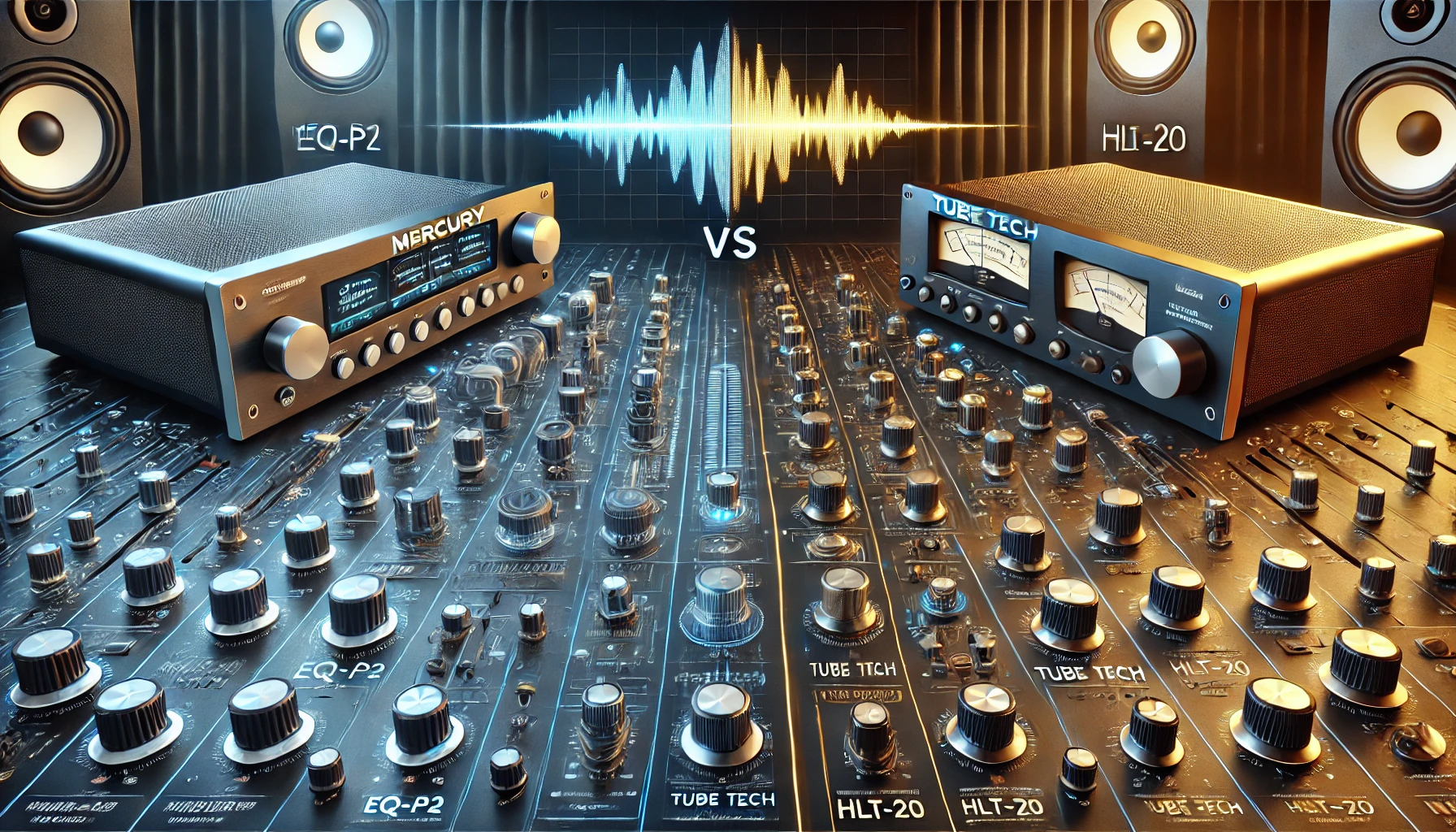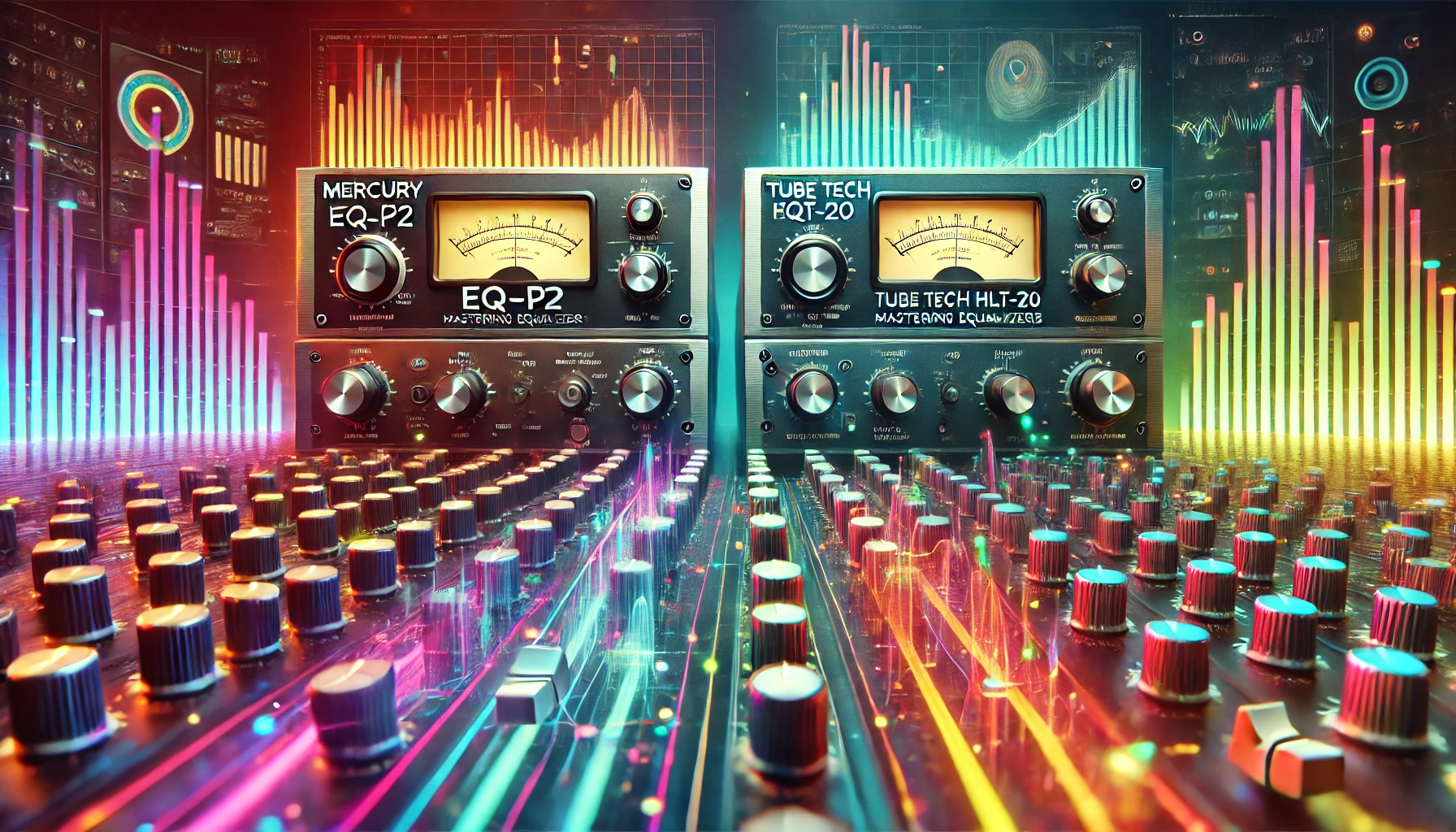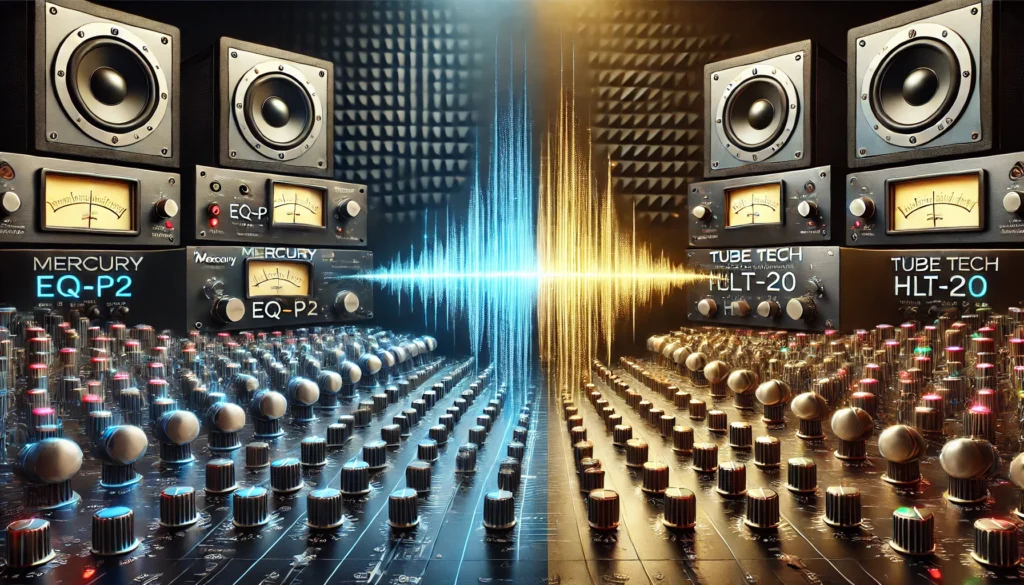Compare Mercury EQ-P2 Versus Tube Tech HLT-20 Mastering: A Comprehensive Guide to High-End Audio Gear
When it comes to mastering, the equipment used plays an integral role in determining the final sound of a track or album. Among the many high-end processors available to mastering engineers, the Mercury EQ-P2 and the Tube Tech HLT-20 Mastering stand out as two of the most respected choices. Both units have earned a reputation for delivering exceptional sound quality, but how do they compare to each other? In this in-depth article, we will compare the Mercury EQ-P2 versus Tube Tech HLT-20 mastering, exploring their features, sound quality, build, usability, and overall value.
Sound Quality: Mercury EQ-P2 Versus Tube Tech HLT-20 Mastering
One of the most important aspects when evaluating any piece of mastering gear is its ability to shape sound effectively. The Mercury EQ-P2 is a highly regarded equalizer, known for its transparent sound and musicality. This unit features a highly flexible, fully parametric EQ with broad bandwidth control, offering engineers the ability to fine-tune frequencies with precision. It delivers clarity and transparency, allowing the audio to breathe while enhancing its natural characteristics without introducing unwanted coloration. This makes the Mercury EQ-P2 an excellent tool for corrective EQ work as well as for boosting particular elements of the track in a subtle yet effective way.
In contrast, the Tube Tech HLT-20 offers a distinctive flavor of warmth and harmonic richness that is a hallmark of tube-driven equipment. The tube-based design of the Tube Tech HLT-20 imparts a certain “vintage” character to the sound, often described as warm, round, and lush. The tube-driven amplification adds harmonic distortion, which some engineers find to be a valuable tool for creating a sense of depth, fullness, and presence in the audio. If you are working with music that needs to stand out with a bit more character and soul, the Tube Tech HLT-20 may be the perfect choice, as it excels in giving a track a rich, analog feel.
Both the Mercury EQ-P2 and Tube Tech HLT-20 are exceptional when it comes to sound quality, but they cater to different needs. The Mercury EQ-P2 is more transparent, while the Tube Tech HLT-20 offers a more colored, harmonic distortion that some may prefer for adding a unique texture to their masters. The decision between the two will largely depend on the sound profile you are looking to achieve.
Features: Mercury EQ-P2 Versus Tube Tech HLT-20 Mastering
When comparing the Mercury EQ-P2 versus Tube Tech HLT-20 mastering in terms of features, there are a few key differences that set them apart. The Mercury EQ-P2 is a versatile equalizer that offers a wide range of features suited to both corrective and creative EQ tasks. Its fully parametric design allows you to adjust the frequency, bandwidth, and gain, providing the engineer with precise control over the sound. In addition, the Mercury EQ-P2 includes low and high-pass filters, which can help in eliminating unwanted low-end rumble or high-frequency hiss. This makes it ideal for achieving clean and balanced masters, where every frequency is accounted for.
On the other hand, the Tube Tech HLT-20 is a bit more focused on adding warmth and vintage characteristics to the sound. It features a parametric EQ as well but emphasizes the integration of tube technology. The Tube Tech HLT-20 boasts a harmonic distortion that is integral to its sound, with an appealing character that comes from the tube-driven design. Its EQ section is flexible but is perhaps more ideal for applications where you need to add weight to the midrange or thickness to the bass. If your project demands a more “analog” touch, the Tube Tech HLT-20 is an excellent choice.
Both units offer high-end features, but the Mercury EQ-P2 is often favored for its transparency and versatility, while the Tube Tech HLT-20 is more likely to be chosen for its tube-driven warmth and presence. The choice between the two will depend on whether you need precision and neutrality or a more saturated, vintage feel.
Build Quality: Mercury EQ-P2 Versus Tube Tech HLT-20 Mastering
In terms of build quality, both the Mercury EQ-P2 and the Tube Tech HLT-20 are crafted to the highest standards. The Mercury EQ-P2 has a modern design with an intuitive interface. Its sturdy, rack-mounted chassis houses high-quality components that ensure longevity and reliability in a professional setting. The front panel is sleek and easy to navigate, offering clear labeling of all the controls, making it straightforward for engineers to work with during long mastering sessions.
The Tube Tech HLT-20, built with a more traditional design philosophy, offers a more classic, robust construction. The use of tubes means the Tube Tech HLT-20 may require a bit more maintenance, as the tubes will eventually need to be replaced. However, many engineers who prefer tube gear find that this kind of upkeep is well worth the exceptional sound quality it delivers. The Tube Tech HLT-20 is built to last, with a heavy-duty chassis that can withstand the test of time. For those who appreciate the tactile feel and warmth that tube-based gear provides, the Tube Tech HLT-20 is a solid option.
Both units are constructed to be durable, but the Mercury EQ-P2 has the edge when it comes to a modern, lightweight design with easy-to-use controls. The Tube Tech HLT-20, while bulkier, stands out for its tube-driven charm, which many users find appealing.
Usability: Mercury EQ-P2 Versus Tube Tech HLT-20 Mastering
Usability is an important factor to consider when selecting a mastering processor. The Mercury EQ-P2 is user-friendly, with its controls clearly labeled and easy to understand. Even for beginners, it’s relatively simple to dial in the perfect EQ settings for your track, and the overall workflow is intuitive. The Mercury EQ-P2 shines when it comes to precision and control, offering clear feedback so you can hear the changes as you make adjustments.
The Tube Tech HLT-20 requires a bit more knowledge and understanding of analog gear. Due to its tube-based design, it can sometimes be a little more difficult to master. However, for engineers with experience using tube processors, the Tube Tech HLT-20 offers a level of hands-on control that is highly rewarding. The tactile nature of the unit’s controls makes it a joy to work with for those who appreciate analog gear.
If you’re looking for something straightforward and intuitive, the Mercury EQ-P2 might be more appropriate, while the Tube Tech HLT-20 will appeal to those who enjoy the unique characteristics of tube gear and are prepared to work with a slightly more complex interface.
Price and Value: Mercury EQ-P2 Versus Tube Tech HLT-20 Mastering
When comparing prices, the Mercury EQ-P2 typically comes in at a slightly lower price point than the Tube Tech HLT-20, making it a more budget-friendly option for those who need high-end mastering gear without breaking the bank. However, the Tube Tech HLT-20 is priced higher due to its tube-based design and the unique sonic character it provides. For audio engineers who value analog warmth and saturation, the investment in the Tube Tech HLT-20 may be worth it.
Both units offer excellent value for the price, but the Mercury EQ-P2 is often seen as a more versatile, transparent tool for a wide range of mastering applications, while the Tube Tech HLT-20 stands out for those looking to add tube warmth and vintage coloration to their tracks.
Conclusion: Mercury EQ-P2 Versus Tube Tech HLT-20 Mastering
In conclusion, when you compare the Mercury EQ-P2 versus Tube Tech HLT-20 mastering, both are exceptional choices that serve different purposes. The Mercury EQ-P2 excels in transparency, versatility, and precision, making it ideal for mastering engineers who need a high-quality, all-around equalizer for corrective and tonal shaping work. On the other hand, the Tube Tech HLT-20 offers a unique, vintage sound, driven by tubes that add warmth, character, and harmonic distortion to a track, which is perfect for those who want to impart a bit of analog magic to their masters.
Ultimately, choosing between the Mercury EQ-P2 and the Tube Tech HLT-20 mastering comes down to the kind of sound you are looking to achieve. Whether you prefer the transparency of the Mercury EQ-P2 or the rich, vintage warmth of the Tube Tech HLT-20, both are top-of-the-line choices for any mastering engineer.
Frequently Asked Questions: Compare Mercury EQ-P2 Versus Tube Tech HLT-20 Mastering
- What is the main difference between the Mercury EQ-P2 and the Tube Tech HLT-20?
The primary difference between the Mercury EQ-P2 and the Tube Tech HLT-20 mastering lies in their tonal characteristics. The Mercury EQ-P2 is known for its transparency, providing clear and precise EQ adjustments without coloring the sound, making it ideal for corrective EQ tasks. In contrast, the Tube Tech HLT-20 introduces a vintage warmth and harmonic richness, thanks to its tube-based design. It imparts a more colored, analog sound, perfect for adding warmth and character to your audio.
- Which unit is better for transparency in mastering, Mercury EQ-P2 or Tube Tech HLT-20?
If you’re looking for transparency, the Mercury EQ-P2 is the better choice. It delivers precise, clean EQ adjustments with minimal coloration, making it a great option for mastering engineers who need accuracy and clarity in their sound. The Tube Tech HLT-20, on the other hand, adds a layer of warmth and tube distortion, which may not be ideal for those seeking pure transparency.
- Can the Mercury EQ-P2 be used for both corrective and creative EQ work?
Yes, the Mercury EQ-P2 is highly versatile and can be used for both corrective and creative EQ applications. Its fully parametric design and broad bandwidth make it perfect for fixing tonal imbalances in a mix, while its transparent sound allows for subtle tonal shaping when needed. Whether you need to clean up the low end or add presence to the highs, the Mercury EQ-P2 offers flexibility for various mastering tasks.
- Is the Tube Tech HLT-20 suitable for all types of music?
While the Tube Tech HLT-20 is an excellent tool for adding warmth and analog character to music, it may be more suited for genres that benefit from a vintage, saturated sound, such as rock, jazz, or analog-style electronic music. The harmonic richness and coloration it provides may not be ideal for genres that require maximum transparency, such as classical or certain types of pop music. That being said, its unique tube-driven sound can enhance any track that benefits from a little extra depth and warmth.
- Which unit is easier to use, the Mercury EQ-P2 or the Tube Tech HLT-20The Mercury EQ-P2 is generally considered easier to use, especially for those new to mastering or EQ work. Its modern, user-friendly interface and clearly labeled controls make it simple to navigate and make precise adjustments. The Tube Tech HLT-20, while rewarding for experienced engineers, may require a bit more knowledge and understanding of analog gear due to its tube-based design and the unique characteristics of tube-driven sound.
- How does the price of the Mercury EQ-P2 compare to the Tube Tech HLT-20?
The Mercury EQ-P2 is typically more affordable compared to the Tube Tech HLT-20. The Mercury EQ-P2 provides excellent value for its price, offering transparency and versatility without the high cost. The Tube Tech HLT-20, due to its tube technology and the vintage warmth it provides, is priced higher but is seen as a worthwhile investment for those who want to add rich analog warmth and harmonic distortion to their masters.
- Which unit is better for adding warmth and character to a track, Mercury EQ-P2 or Tube Tech HLT-20?
The Tube Tech HLT-20 excels in adding warmth and character to a track. Its tube-driven amplification imparts a harmonic distortion that adds depth, richness, and a vintage feel. If you’re looking to give your tracks a more analog, soulful touch, the Tube Tech HLT-20 is the better choice. On the other hand, the Mercury EQ-P2 is designed for transparency and clarity rather than adding warmth.
- Can the Tube Tech HLT-20 be used for high-precision EQ adjustments like the Mercury EQ-P2?
The Tube Tech HLT-20 does offer precise EQ control, but its design is more focused on adding warmth and harmonic distortion rather than on surgical, high-precision EQ adjustments. While it does feature parametric EQ settings, it’s not as versatile or transparent as the Mercury EQ-P2 when it comes to fine-tuning specific frequencies with accuracy.
- Is the Tube Tech HLT-20 suitable for digital mastering or is it more for analog use?
The Tube Tech HLT-20 is designed with an analog signal path, so it’s primarily used in analog mastering setups. That being said, it can be incorporated into a hybrid mastering system where both digital and analog equipment are used together. However, it shines most when working within an entirely analog chain, where its tube-driven warmth can truly be appreciated.
- Does the Mercury EQ-P2 offer any additional features like filters or compression?
Yes, the Mercury EQ-P2 comes equipped with both low and high-pass filters, which are useful for cutting unwanted frequencies in the low and high ends. However, it does not include built-in compression, which allows it to maintain a more transparent signal path. It’s an equalizer designed specifically for tonal shaping and frequency manipulation.
- Which unit has better build quality, the Mercury EQ-P2 or the Tube Tech HLT-20?
Both the Mercury EQ-P2 and Tube Tech HLT-20 boast excellent build quality, but the Mercury EQ-P2 has a more modern, lightweight design. It is built with professional-grade components and is rack-mounted for easy integration into your studio setup. The Tube Tech HLT-20, being a tube-based device, is slightly bulkier, with a traditional design and heavy-duty construction meant to stand the test of time.
- How do the Mercury EQ-P2 and Tube Tech HLT-20 compare in terms of maintenance?
The Mercury EQ-P2 is relatively low-maintenance, with no tubes to worry about replacing. It’s designed to be durable and reliable for long-term use. The Tube Tech HLT-20, however, uses tubes in its signal path, which will eventually need to be replaced to maintain optimal sound quality. Regular maintenance is required to ensure the longevity of the tubes and the overall performance of the unit.
- Can both the Mercury EQ-P2 and Tube Tech HLT-20 be used for stereo mastering?
Yes, both the Mercury EQ-P2 and Tube Tech HLT-20 are designed for stereo mastering. The Mercury EQ-P2 features dual-channel operation, giving precise control over both the left and right channels, which is crucial for mastering stereo tracks. The Tube Tech HLT-20 also operates in stereo, though it may offer a more distinct coloration due to its tube-driven design.
- Is the Tube Tech HLT-20 better for vintage or modern music?
The Tube Tech HLT-20 is especially well-suited for music that benefits from a vintage, analog feel. Its tube technology adds warmth and harmonic richness, making it ideal for genres such as rock, jazz, and certain types of electronic music. While it can still work with modern music, its true strength lies in its ability to enhance the natural analog warmth in vintage or analog-style recordings.
- How do I decide which one to purchase, the Mercury EQ-P2 or the Tube Tech HLT-20?
The decision between the Mercury EQ-P2 versus Tube Tech HLT-20 mastering depends on your needs and preferences. If you prioritize transparency, precision, and versatility, the Mercury EQ-P2 is likely the better choice. However, if you’re seeking warmth, vintage character, and a more saturated analog sound, the Tube Tech HLT-20 will be a more suitable option. Consider the type of music you work with and whether you need a more neutral EQ or one that imparts additional color to the sound.

